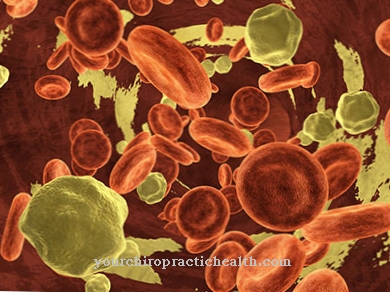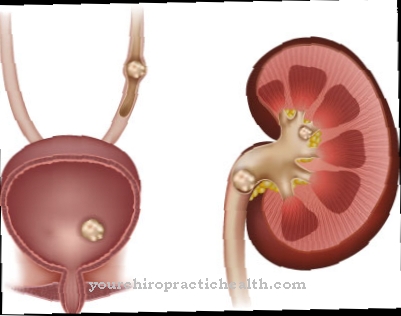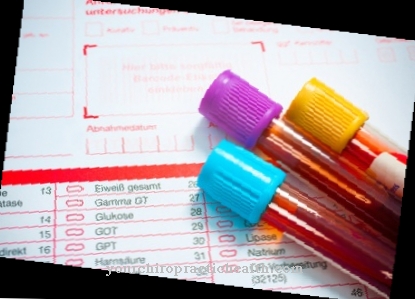The Post-zoster neuralgia is a complication of shingles. It is probably the result of permanent damage to the nerve by the varicella zoster virus.
What is post-zoster neuralgia?

© phadungsakphoto - stock.adobe.com
The Post-zoster neuralgia (PZN) occurs in 10 to 15 percent of all patients with shingles (herpes zoster). Those affected suffer from neuropathic pain in the area of the previous herpes zoster infection. In the case of herpes zoster on the face, PZN occurs significantly more frequently than in other zoster locations.
The likelihood of developing post-herpetic neuralgia after shingles also increases with age. The pain is sometimes very severe. Painkillers do not help, or only little. There is no cure for post-herpetic neuralgia, the pain persists. Due to the persistent severe pain, patients with PZN are often suicidal.
causes
Post-zoster neuralgia is caused by an infection with the varicella zoster virus. Such an infection is also known colloquially as shingles. The varicella zoster virus belongs to the herpes virus family. It is closely related to the herpes simplex virus. It is estimated that the level of infection with the virus is high. Around 90 percent of all Europeans over the age of 14 are carriers of varicella-zoster viruses.
The pathogens rarely cause diseases with a fatal outcome. This shows how strongly the viruses have adapted to their reservoir host, humans. The initial infection with the virus usually manifests itself as chickenpox. The pathogens are transmitted by droplet infection. Smear infections are also possible. After the chickenpox disease subsides, sufferers are immune to chickenpox for a lifetime.
However, the varicella zoster virus remains in the body. A suppressed immune system can reactivate the virus at any time later. Frequent triggering factors are stress or strong sunlight. The viruses persist in the nerve roots of the spinal cord, in the so-called spinal ganglia, and in the ganglia of the cranial nerves.
If the virus reactivates, chickenpox will not recur, but shingles. Post-zoster neuralgia is the result of impaired transmission of stimuli that the viruses cause on the nerves. The viruses can leave permanent damage to the affected nerves. These cause the chronic pain.
Symptoms, ailments & signs
Post-zoster neuralgia is always the result of shingles. The viral disease appears as a painful skin rash with blisters on one side of the body. The rash runs in stripes on a certain dermatome. A dermatome is an area of skin that is innervated by a spinal nerve.
In most cases, shingles is preceded by a so-called prodromal stage. At this early stage, symptoms such as fatigue, fever and fatigue appear. Burning, pain, and abnormal sensations can also occur in the affected dermatome. The typical rash does not appear until a few days later. The nerve tissue is inflamed and people suffer from burning sensation and severe pain in the dermatome that is supplied by the inflamed nerve.
The nerve itself can also hurt. Within a few days, the vesicles that have formed fill up and break open. It can take two to four weeks to heal. The pain also usually subsides within a few weeks. However, permanent nerve damage can cause neurological pain to occur for a very long time.
These are known as post-zoster neuralgia. The pain can appear in different forms. It can be permanently burning and boring or occur in the form of short and violent attacks of pain. Severe touch pain is also typical of post-zoster neuralgia.
Diagnosis & course of disease
The diagnosis is made based on symptoms, medical history, and a physical exam. If the post-zoster neuralgia occurs in younger patients, the reasons for the immunodeficiency should always be investigated. In young patients, post-herpetic neuralgia occurs only in very rare cases without an immunosuppressive cause.
The immune system disorders can be acquired or congenital. Malignant diseases such as tumor diseases and leukemias must always be clarified. Systemic diseases and infectious diseases such as AIDS should also be excluded.
Complications
Depending on the intensity and duration of the post-therapeutic pain, depressive moods, the development of clinically manifest depression, easy fatigue and exhaustion can occur. Also difficulty falling asleep and staying asleep, - decreased appetite and also difficulty concentrating. Those who have had neuropathic pain for more than a year are at greatest risk for these complications.
A high pain intensity also increases the likelihood of long-term effects. Since the treatment of post-herpetic neuralgia is symptomatic according to the quality of the pain, complications can also arise from inadequate or incorrectly performed pain therapy treatment.
This applies in particular to antidepressants with the active ingredients nortriptyline, duloxetine and venlafaxine, which are used both to treat depression and in pain therapy. Dosages that are usually chosen for the treatment of neuralgia are often insufficient for the treatment of depression and may have to be adjusted.
Anticonvulsants with the active ingredients gabapentin and pregabalin, which are also used to reduce post-therapeutic pain, can aggravate existing complications such as tiredness and poor concentration.
This applies to an even greater extent to pain relievers from the class of opioids (tramadol, oxycodone, morphine). Their partially desirable sedative effect can, in interaction with existing complications and other painkillers, lead to severe tiredness, drowsiness and confusion. To avoid complications, the pain therapy should therefore be adjusted regularly.
When should you go to the doctor?
If you suddenly experience severe nerve pain, it is advisable to see a doctor. Post-herpetic neuralgia can be treated well if it is recognized early. Therefore, any initial nerve problems, problems with moving the limbs and other unusual phenomena should be examined and treated by a doctor if necessary. Anyone who recently contracted the varicella zoster virus should consult their family doctor. The neuralgia may have been triggered by the pathogen. People with a weakened immune system, nervous disorders and severe shingles should also consult their doctor if the symptoms described occur.
Medical advice is required at the latest when the symptoms have a very negative effect on well-being or lead to further physical or emotional complaints. In addition to the general practitioner, post-herpetic neuralgia can also be seen by a neurologist or internist. Chronic illnesses may require inpatient treatment in a specialist clinic. Those affected should discuss with the doctor which measures promise the best chances of recovery with regard to the symptoms and any previous illnesses.
Therapy & Treatment
Post-herpetic neuralgia can only be cured in very rare cases. If the disease started less than six weeks ago, a sympathetic block can be done. In intravenous regional sympathetic blockade, a drug is injected into a vein that is right next to the affected skin area. The administered sympatholytic drug can relieve the pain.
If the illness persists for more than six weeks, this method is not promising. The affected patients receive pain relievers such as tramadol or pregabalin. Antidepressants or gabapentin are also administered in low doses. They can inhibit the transmission of pain in the brain and at the same time alleviate depressive moods. Many patients with post-herpetic neuralgia experience depression because of the severe pain.
Psychotherapy can also be carried out to make it easier for patients to cope with their illness. In some cases, topical anesthetic ointments or plasters are used. Some doctors also use capsaicin cream to treat post-herpetic neuralgia. The capsaicin, an active ingredient in chili pepper, binds to the pain receptors in the skin and disrupts the transmission of stimuli.
In addition to pain medication, transcutaneous electrical nerve stimulation (TENS) can be performed. The patient wears a small device that is connected to the affected skin area via an electrode. If pain occurs, the patient can give off electrical impulses. These irritate the skin nerves and hinder the transmission of pain impulses.
You can find your medication here
➔ Medicines for rash & eczemaprevention
To prevent post-herpetic neuralgia, any shingles should be treated early with antiviral drugs such as valaciclovir and acyclovir.
Aftercare
After the actual herpes infection has subsided, some patients may experience discomfort or pain in the affected area. The treatment of these symptoms requires the active cooperation of the patient, otherwise the symptoms can become chronic. First of all, it is important to take the medication prescribed by the doctor correctly.
In addition, pain reliever gels help. Acupuncture and TENS therapy have also shown success in treatment. TENS therapy is a gentle variant of electrotherapy. A stimulation device generates electrical stimulation that blocks the conduction of excitation in the nerve fibers so that they cannot transmit the pain impulse to the brain. TENS devices are also available for use at home, which significantly simplifies their use.
Appropriate relaxation techniques, such as Jacobson's progressive muscle relaxation, can also help against discomfort and pain. Yoga, Reiki or certain breathing exercises also enable the patient to alleviate the symptoms of post-zoster neuralgia and to deal with them more calmly. In particularly severe cases or if the pain has already become chronic, psychotherapeutic therapy can be used in addition to drug treatment, which should help the patient to lead a largely independent and carefree life.
You can do that yourself
These discomforts or pain that occur after a herpes infection are particularly annoying for the patient because the actual infection has already subsided. Nevertheless, you should actively participate in the treatment, otherwise the symptoms could become chronic.
Treatment includes correctly taking the drugs prescribed by the doctor. Pain relieving gels can also be used. In addition, IGEL services such as acupuncture and TENS therapy have proven themselves. In TENS therapy, electrodes are attached to the painful areas, through which a stimulation current of 80 to 120 Hertz is then passed. The tingling sensation on the skin that this creates superimposes on the one hand the pain and on the other hand allows the body to release endorphins. These endorphins attach to the pain receptors. In this way, electrical stimulation therapy can switch off pain. TENS devices are also available for home use, which simplifies their use.
Relaxation techniques can also help against the pain and discomfort. For example, the effective and easy-to-learn progressive muscle relaxation according to Jacobson is recommended. Meditations, breathing exercises, Reiki, yoga and tapping acupressure EFT are also good ways to set accents against pain and to deal more calmly with post-zoster neuralgia.
If the pain is particularly severe or has already become chronic, it is advisable to undergo psychotherapeutic treatment in addition to drug therapy.





.jpg)


















.jpg)



